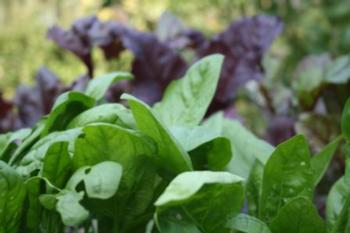Unused stories
Growing In Your Garden Now - Spinach

A cool climate is best for producing spinach (Spinacia oleracea). It is fast growing and short-lived and matures its leafy foliage in 7 weeks. Spinach then quickly goes to seed, although it produces for a longer period in the cool, coastal areas before seed stalk development occurs. New Zealand spinach, which forms short runners and resembles regular spinach in leaf shape, is frost sensitive but tolerates warm weather much better than regular spinach. It is productive all season and can be cooked or used raw in salads.
Spinach is generally seeded directly into the garden, and not transplanted. It should be planted on raised beds, made by adding large amounts of sifted compost or other soil amendments so that a bed is established above the previous level of soil. At each place a plant is desired, scatter 6 to 8 seeds on moist soil. Plant a greater stand than necessary so as to make up for any losses from insects such as cutworms. With your finger, push the seeds into the soil 0.5 to 0.75 of an inch deep. Fill these holes by scratching the surface, firm the soil lightly, and cover with a thin mulch of grass clippings or other organic material in order to hold soil moisture. Water well and keep moist during the germination period. When plants are up and growing, thin to 3 to 6 inches apart. You can grow two rows in beds that are 38 to 40 inches across. Germination takes place in about 10 days at 40° F. In areas with long seasons, continue to sow every 2 to 3 weeks for a longer harvest. If growing spinach during the summer, young seedlings can be protected with 50% shade cloth or 2 layers of floating row cover until they have about 6 leaves. This helps protect them from sunburn as well as seedling pests such as flea beetles, leafminers, snails, and slugs and possibly from birds.
Spinach has a fairly shallow root system and does best with frequent and shallow irrigation. Ideally, it is best to irrigate with sprinklers to get the crop up from seed, but then switch to flood or drip irrigation to avoid too much moisture on the leaves. Avoid saturated soil conditions, which favor the development of crown and lower leaf rot.
Harvest spinach as soon as the leaves are large enough to use. You can use the thinnings in salads and for steaming. Once the plants mature, it is best to harvest the whole plant rather than just the outer leaves. Spinach freezes very well.
For more information on growing spinach, click here.
Edited by Nanette Londeree from UC Davis, Vegetable Research and
Information Center and UC IPM Online information.
